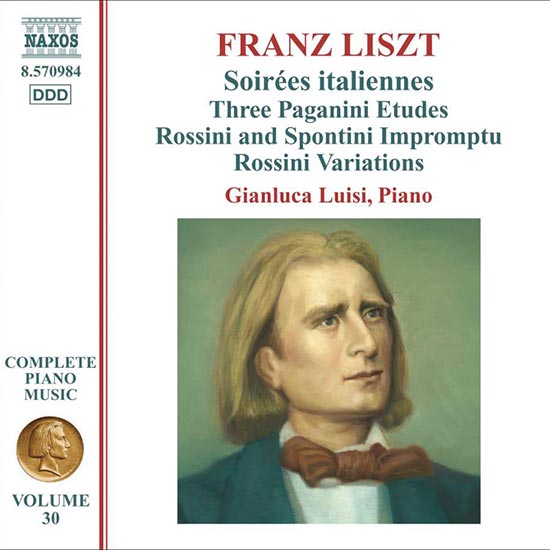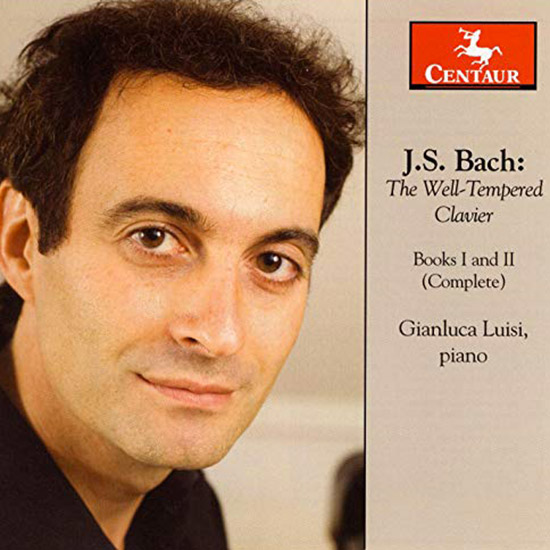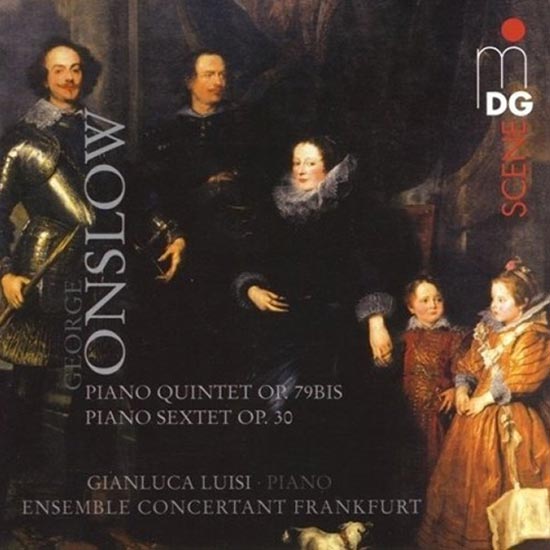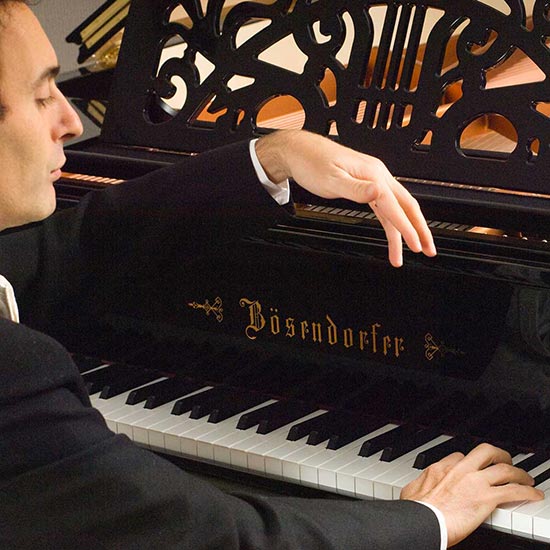Gianluca Luisi is an excellent choice in these early Romantic piano arrangements radiant with Italian sunshine.
“ The character of instrumental music… lets the emotions radiate and shine in their own character without presuming to display them as real or imaginary representations.” Liszt
Now standing at volume 30 this continuing Naxos series maintains an impressive level of consistency with this disc featuring arrangements of Italian opera composers. Across the series Naxos have utilised the talents of several soloists the majority of whom were new names to me. On this volume the soloist is also unfamiliar but the label’s scouts are clearly expert at talent spotting as Italian-born pianist Gianluca Luisi performs with assurance and considerable brio.
Earlier this year I was dazzled by the playing of the Kanazawa-Admony Piano Duo in volume 29 in the series comprising two-piano transcriptions of four of Liszt’s symphonic poems on Naxos 8.570736. In 2008 I especially enjoyed volume 28 in the series which was Liszt’s two piano transcription of Beethoven’s Symphony No. 9 . Previously, I had selected two discs from this series as my ‘ 2007 Records of the Year’: volume 24 played by Giuseppe Andaloro on 8.557814 and volume 25 played by Alexandre Dossin on 8.557904.
Before it was possible to reproduce performances electronically the majority of music-lovers only had access to the popular orchestral and operatic scores of the day in pared-down arrangements for performance in the drawing room or salon. Liszt was the undisputed master of the ‘art of the transcription’, making numerous piano arrangements of the music of mainly popular contemporary composers. These he played in his own recitals.
Completed in 1838 the Soirées italiennes, S411 are free piano arrangements known as six amusements based on motifs from a collection of songs by Saverio Mercadante, an admired Neapolitan composer, principally of operas. It seems that Liszt dedicated the score to the Archduchess Elisabeth of Austria. The set of six Soirées italiennes are genuinely elegant, attractive and undemanding piano pieces that in the hands of Gianluca Luisi amuse and delight. They vary splendidly from the relaxed elegance of La primavera (track 1) to the action-packed entertainment of the dance-infused Galop (track 2) to the brash arrogance of the drinking song Il brindisi (track 5). It’s a shame that Mercadante the composer of the original themes is not acknowledged in the titles to this release.
Liszt first heard Paganini perform in 1832 at a Paris recital. This event was to inspire the young Liszt to embark on a career as a touring virtuoso. It was in 1838 that Liszt prepared the Études d’exécution transcendante d’après Paganini, S140 a set of six challenging studies based on themes from Paganini’s 24 Caprices for solo violin and other works. In 1840 the set was published and later revised and republished in 1851. Of the three Études on this disc the best known by far is the sixth based on Paganini’s famous and oft-transcribed Caprice No. 24 in A minor. I like the way Luisi traverses the complex and virtuosic demands of the moody Étude No.1. A study in arpeggios the Étude No.4 is akin to a perpetuum mobile and the celebrated Étude No.6 is a delightful yet serious display piece with that killer melody.
From 1824 the Impromptu brillant sur des thèmes de Rossini et Spontini, S150 is an early work from the year of Liszt’s Paris debut and bears a dedication to Countess Eugénie de Noirberne. The score includes themes from Rossini’s operas La donna del lago and Armida, and Gaspare Spontini’s opera Olimpie and Fernand Cortez. A marvellous piece, the Impromptu is high on melody and broad in entertainment value. Possibly the themes are a touch lacking in variety which is probably the reason the score is not played more often in piano recitals.
Liszt knew the Parisian-based Gioachino Rossini and prepared several fantasias on themes from his operas. Dating from around 1824 Liszt’s Sept variations sur un thème de Rossini, S149 uses themes from Rossini’s opera Ermione. Liszt’s score is dedicated to Madame Panckoucke who was well connected and from an eminent publishing family. Luisi is fresh and exhilarating in the agreeable and dazzling virtuosic Sept variations.
Splendidly performed and recorded in Vienna this volume in the continuing series shows no sign of flagging. Luisi is an excellent choice in these undemanding early Romantic piano arrangements so radiant with Italian sunshine.
This Italian-flavored collection gathers up some of Liszt’s more obscure piano works leavened, oddly, by three chestnuts drawn from the Paganini Etudes. The Impromptu and the Variations, both from 1824, are the products of a precocious and exuberant teenager who, though still confined by the conventions of the day, nonetheless manages to keep our attention by using his cage as a jungle gym on which to perform the brilliant, if sometimes foursquare, acrobatic feats that helped secure his reputation as a performing wunderkind; the slightly later Soirées italiennes (1838), based on songs by Mercadante, intermittently shows a more supple imagination, a freer approach to the instrument, and a greater resistance to the tyranny of the barline. None of these rarities in any way suggest the iconoclastic genius to come—but all three provide flashes of pleasure.
They’re especially effective in the hands of Gianluca Luisi. These are, at their best, sweetly refined performances notable for their gentle ardor: their silken lines, their pastel colors, their flexible rubato, and their careful attention to harmonic nuance. Not that Luisi doesn’t have a solid technique. There’s plenty of splash, for instance, in the more bravura moments in the Variations; the first of the Paganini Etudes has a fine melodramatic swagger; and the fourth is tossed off with an enviably debonair legerdemain. But on the whole, the less aggressive music (especially in the Soirées) makes the most lasting impact; in some of the more outgoing music — say, the Galop in Soirées or the sixth of the Paganini Etudes — Luisi’s playing can thicken.
Keith Anderson’s notes are good; Naxos’s sound is slightly gray and lacking in presence. All in all, if you have a weakness for even the lower rungs of 19th-century piano music and you don’t already have the Leslie Howard recordings (which trade in some spontaneity for a tighter focus), this disc is warmly recommended.
Liszt’s reputation as a composer has always been a controversial and phlegmatic one, veering as he did between what seems to some as cheap, empty paraphrases of operatic music, superfluous arrangements for keyboard of the Beethoven symphonies, and more “serious” works that nevertheless also contain elements of flashiness. Certainly, one seldom encounters a pianist who makes his or her living playing the more culturally elite repertoire of Bach, Mozart, Beethoven, or Schubert playing Liszt, although Dinu Lipatti was famous for his performances of Liszt’s piano concertos (inhabitants of his more serious wing), but Gianluca Luisi plays these pieces with so much joy, as well as so much musical integrity, that it’s nearly impossible to brush them off as mere entertainment. Indeed, it may be that it is exactly because Luisi has spent so many years playing more substantive and less showy repertoire that these performances work so well. Certainly the crystalline tone of his Bösendorfer has a lot to do with hearing all the structural clarity in these works, but Luisi’s incredibly crisp articulation and (as I said) somewhat more serious mein bring the listener’s focus to the quality of the music without making an undue fuss over its technical difficulty. To give but two examples: The final Bolero of the Soirées italiennes has all the swagger one might wish in it, yet at the same time Liszt’s command of chordal richness and exuberant use of power shine through, while in the Paganini Étude No. 4, Luisi flies over the keyboard with elfin grace, always drawing the listener inward but never, ever in a way that brags of his digital dexterity. In the Seven Variations on a Theme of Rossini, Luisi finally lets his bravado out of the bottle, so to speak. The performance is so effervescent, so bubbling over with joy and wit, that at the end you almost feel like jumping out of your seat and applauding. It’s that good.
My only question is, since this disc is Vol. 30 in the complete piano music of Liszt, Luisi was only asked (or allowed, I’m not sure which) to record three of the six Paganini etudes. Surely this means that someone else is going to record Nos. 2, 3, and 5—perhaps Luisi himself, perhaps another pianist. The sound quality is fantastic. These are the kinds of performances that lift ostensibly shallow, flashy pieces up and make true art of them. As several jazz pianists said of the great Art Tatum, there’s nothing in these performances that will scare you away unless you also happen to be a pianist.
Dita d’acciaio e tocco incisivo, Gianluca Luisi dispone di un grande volume di suono e offre un fraseggio scolpito con gesti robusti sulla tastiera del suo Bösendorfer Imperial, pianoforte che rappresenta sempre una gioia per le orecchie. Sotto questo aspetto i lisztiani tre Grandi Studi da Paganini affrontati nel primo dei due CD pubblicati dalla Naxos sono un’interpretazione esemplare, anche in virtù della buona qualità tecnica della registrazione. Certo, Luisi non è un virtuoso-monstre come Hamelin o come il Carlo Grante di qualche anno fa, però i suoi Studi da Paganini temono pochi confronti.
Non si può dire lo stesso delle più fragili Soirées italiennes, che richiedono agli interpreti una leggerezza salottiera, una fantasia, una « souplesse » di fraseggio e di tocco estranee al pianismo di Luisi. Funzionano, tra le Soirées, quelle più spiccatamente virtuosistiche, come la Serenata del marinaio, il Brindisi e soprattutto la Zingarella spagnola, risolta tutta nel segno di una brillantezza scintillante anche se poco raffinata per quanto riguarda le sfumature timbriche e dinamiche. Lo stesso si può dire per i due pezzi da concerto su temi di Rossini composti nel 1824 da un Liszt poco più che dodicenne ai tempi del suo esordio a Parigi: qui la brillantezza non basta, quando non sia sorretta da un delicato lirismo, già percorso da fremiti romantici (soprattutto per l’Impromptu, dove Liszt riprende il Rossini de La donna del lago e non il Rossini del Barbiere!).
Altro è il discorso da fare per l’interessante CD cameristico dedicato alla figura del tedesco Ludwig Thuille (1861–1907), compositore, pianista e didatta amico di Richard Strauss, che rappresenta una bella scoperta discografica, anche se a dire il vero il Sestetto op. 6 per pianoforte e fiati ha sempre goduto di una certa notorietà. Questo Sestetto potrebbe essere ascritto tranquillamente alla penna di Brahms per la qualità dell’invenzione tematica in relazione al timbro dei singoli strumenti, sfruttati in tutte le loro peculiarità. Si veda come il corno trovi in ogni situazione un ruolo a lui perfettamente congeniale, fin dalle prime battute dell’Allegro moderato d’apertura. Anche il timbro del pianoforte si amalgama bene con quello dei fiati, senza dubbio in virtù dell’ottima qualità della scrittura di Thuille, ma anche grazie alle peculiarità timbriche del Bösendorfer Imperial. Lo stesso avviene nel Quintetto op. 20, dove è spesso il pianoforte a sostenere gli archi, in particolare nel commuovente Adagio assai sostenuto, anche se il Quartetto Gigli non ci sembra esibire la stessa compattezza sonora del Quintetto Chantily.
In veste di camerista Gianluca Luisi rivela un controllo, un’eleganza ed un’attenzione agli equilibri dell’insieme insospettabili per un virtuoso e che forse si devono alla sua costante pratica della musica di Bach. E la circospezione con cui tratteggia i sinistri cromatismi nel citato Adagio del Quintetto, cromatismi che sembrano venire dal Wagner del Tristan, dal Brahms dei Preludi-Corali per organo se non addirittura—in anticipo di quasi mezzo secolo!—dal Richard Strauss degli anni quaranta del Novecento, dà tutta la misura della sua sensibilità di interprete.
It must have been a constant battle for Franz Liszt to titillate his audiences with works of ever increasing technical bravura, often resorting to paraphrases to maintain the unending flow. He turned to Mercadante to provide the themes for the six sections that form the Soirees italiennes, the attractive melodies mixing lyric passages with moments of hair-raising difficulty.
Il galop and Il brindisi stand beside the charm of Il pastore Svizzero (The Swiss shepherd), and a brilliant Bolero brings it to a conclusion. It was seeing the great violin virtuoso, Paganini, that drove the seventeen year old Liszt to seek the same level of perfection in his piano playing. As a tribute he wrote his Etudes d’execution transcendante d’apres Paganini as a set of six studies that were published in 1840, but enlarged and somewhat simplified for the version we normally hear and published in 1851. This disc includes three of those that were changed in the enlarged score, the Sixth being the study on Paganini’s famous Capriccio No. 24.
He was only thirteen when he completed the Impromptu brillant sur des themes de Rossini et Spontini, the themes coming from two operas by each composer that are unknown today. He must have been a brilliant prodigy to play such a score. The release ends with Sept variations sur un theme de Rossini composed the same year and using music from the opera, Ermione.
The disc is played, appropriately, by an Italian pianist, Gianluca Luisi, who gives very literal readings that show an affinity with Liszt in brilliant mode, but is at his best in those passages that thrive on affection. Playing a superb Bosendorfer piano, the recorded sound has the required weight and impact.






